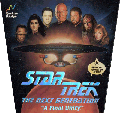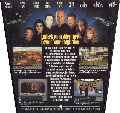Star Trek: The Next Generation “A Final Unityâ€
First posted on 26 December 1998. Last updated on 15 May 2011.
While Interplay Productions has been the company to beat in adventure games based on the Star Trek license, Spectrum Holobyte has done a remarkable job of making a distinctive, enjoyable, and even deep adventure from the exploits of Picard and company. With top notch voice acting, multiple narrative paths, various difficulty settings, challenging puzzles, and gorgeous graphics, Star Trek: The Next Generation "A Final Unity" is definitely a game that Star Trek fans can come back to again and again.
The story behind Star Trek: The Next Generation "A Final Unity" is subtle and sweeping, bringing in many of the elements that make Star Trek: Judgment Rites such a joy to play. The game opens in the exact fashion as an episode of Star Trek: The Next Generation on television (a small touch that makes the game even more immersing). The story begins as the Enterprise finds itself pulled into a dispute between a group of Garidian (friends of the Romulans) political convicts asking for asylum from the Federation and a Garidian warship that is in pursuit.
Playing out in an episodic format, the story initially unfolds in the form of several mini-adventures which run the gamut from saving a damaged space station to solving a whodunit mystery on a nature preserve planet. However, the game soon turns into a larger, movie like extravaganza as it becomes apparent to Picard and his crew that big trouble is afoot in the galaxy. A race against time begins between the Federation, the Romulans, and the Chodak which is an ancient and once powerful race that has ruled the galaxy almost a million years ago but is now thought to be dead. These political powers are trying to locate an ancient artifact of great power known as the Unity Device. It is up to the Starship Enterprise to determine the secret of this device and prevent it from falling into the wrong hands. Whoever wins this race may be the one to determine the evolution of the galaxy for the next million years.
The production values of this game are top notch for its time. The film clips are impressive, and a "Holodeck" feature inside the game allows you to watch cut scenes again and again to your heart's content. The graphics are well drawn, including all the main characters from Star Trek: The Next Generation that have been rendered in almost perfect fidelity compared with their real life counterparts. Ironically, the only real problem is that there are so much details in many of the background scenes that it is difficult to pick out the hotspots on occasions. The voice acting stands out as one of the best voice tracks ever added to computer games. The game features lifelike 3D animation of the Enterprise crew, authentic digitized sound effects and music, and fully digitized voices of the original cast of the series, excluding Denise Crosby and Wil Wheaton. The principal casts include Patrick Stewart, Jonathan Frakes, Brent Spiner, Marina Sirtis, LaVar Burton, Michael Dorn, and Gates McFadden. Over 60 minutes of audio dialogs have been recorded individually with Patrick Stewart, Brent Spiner, and Marina Sirtis.
The game is somewhat hardware intensive, although most of the installation bugs that once heavily plagued the game now appear moot with the hardware currently available. Back in 1995, the game really does not run well without a high end 486 and 16 MB of RAM. Due to incompatibility with some older CD-ROM drives which can only read 63 minute capacity CD rather than the standard 74 minute capacity CD, a 63 minute capacity 2-CD release of the game is also available in addition to the standard 74 minute capacity 1-CD release.
The game plays as a standard, icon based, point and click driven fare. However, a feature that stands out is the variable levels of difficulty. There are 3 levels to choose from—Ensign, Lieutenant, and Captain. The higher in level you choose, the more carefully you must weigh your decisions, and the less coddling and aid you get from your crew. Be sure to weigh your choices carefully! There are multiple paths within the game; I have once found out that I can avoid a more difficult path to discover a set of coordinates only if I have picked my words more carefully with the ancient Chodak. In the highest level of difficulty, you need to assemble your own Away Team, instead of having once automatically picked for you.
The puzzles are pretty straightforward and logical. As long as you select the best crew for a particular mission (which, at lower skill levels, the game automatically does this for you) and constantly make use of your Starfleet issued tricorder, you should not have too many problems. The design team should get extra kudos for paying attention to the fact that every team member in Star Trek has his or her own unique skills to contribute. You may even find yourself going back to get a new crew member who can give you a second opinion. Is Data not analyzing the situation right? Maybe Geordi can use his visor to shed a little light on the situation!
The challenges and tasks in this game all fit well within the Star Trek universe, with one great exception. While exploring a planet in search of some Chodak secrets, the inordinate number of logic puzzles you have to play through seems a bit unrealistic and trying. There are a few other game elements which can be substantially improved. First, I feel that the designers have focused excessively on the Away Team paradigm and have almost forgotten that we are on a Starship that is the size of a small town. While there are some key scenes that are played out on the ship, there are no real adventures that take place primarily aboard the Enterprise. You are not allowed to go freely exploring the ship or interact with its crew. The ship merely serves as a wagon you ride to move around, get into battles, and further the plot.
Speaking of getting into battles, this has to be my least favorite part of the game. The battle interface is cumbersome and the graphics used in the battle sequences are both rudimentary and difficult to see. Without computer assistance with either tactical or engineering or both, this cumbersome interface makes it nearly impossible for you to exert rapid controls in both tactical and engineering to fair well during battle. You spend time giving orders on attack maneuvers while you keep your eye on complex engineering and tactical systems. Fortunately, you can delegate these tasks to Geordi and Worf, respectively, who are actually quite good in doing their jobs. In truth, I may not even be writing this article if help has not been available to me to get through the few completely insane battles! On the other hand, if you find that you just cannot get enough of smashing big spaceships into little debris, the game gives you the option of sending the Enterprise into the Neutral Zone for a little Romulan smashing fun.
Mere words do not begin to describe how impressed I am with the entire story behind this game. Epic in its scope, it feels like I am playing through a extremely well written piece of Star Trek fiction. The story is quite long and twisty and keeps you guessing until the last minute. In the end, is this not what a good adventure is supposed to do? The designers have obviously invested the proper time and resources towards developing the story, which in my opinion, has really yet to be topped by any of the other games based on the Star Trek license. Only Star Trek: Secret Of Vulcan Fury has the potential to surpass it; then again, we shall never find out!
Spectrum Holobyte has done a splendid job developing the Star Trek license. Star Trek: The Next Generation "A Final Unity" is an excellent game that has an interesting story, decent voice acting, and even semi-nonlinear gameplay. Aside from the annoying battle sequences, it is relatively fast paced since hints are offered frequently and freely to prevent novices from getting stuck. Adding multiple narrative paths is a great way to inject replay value to this title. With the recent cancellation of Star Trek: Secret Of Vulcan Fury, the future of Star Trek adventure games unfortunately appears bleak. Let us hope that Activision, the new holder of the Star Trek license, wises up and make sure that A "Final" Unity does not become the "final" Star Trek!





